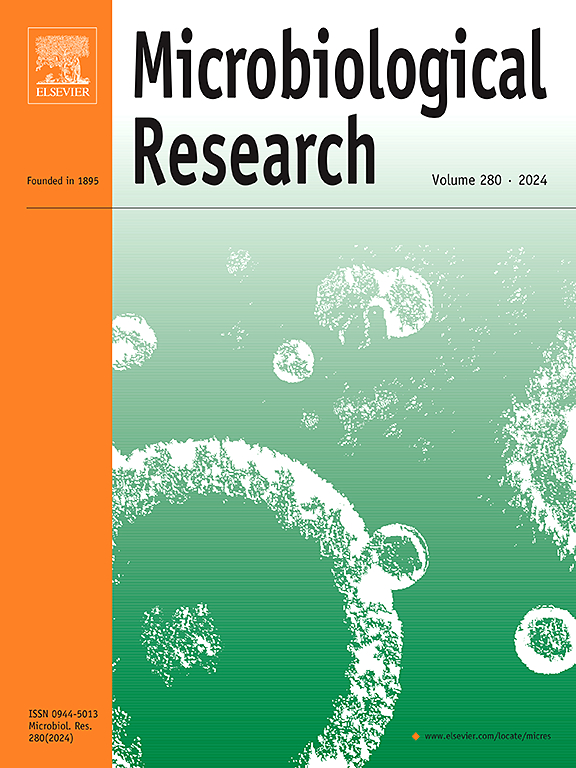在pgpr辅助镉镍污染土壤的植物修复中,MWCNTs对植物生长和修复效率的双重作用
IF 6.9
1区 生物学
Q1 MICROBIOLOGY
引用次数: 0
摘要
镉(Cd)和镍(Ni)是造成土壤重金属污染的主要元素,对作物和生态系统造成不可逆转的危害。目前,植物促生根瘤菌(PGPR)辅助植物修复污染土壤的技术研究越来越受到重视。同时,近年来,多壁碳纳米管(MWCNTs)因其高比表面积和强吸附性也被探索用于HMs污染修复。MWCNTs可能通过直接固定HMs和间接促进植物生长来提高HMs污染土壤的植物修复效率,但关于MWCNTs在pgpr辅助植物修复过程中可能的双重增强作用的研究较少。因此,本研究创新性地探讨了MWCNTs在水稻镉镍污染土壤的pgpr辅助植物修复中的潜在作用。结果表明,MWCNTs的存在进一步提高了PGPR协助植物修复的修复效率,使土壤Cd2 +和Ni2+含量分别降低20.4 %和13.7 %,优于菌株BT单独处理。扫描电镜结果表明,PGPR可以附着在MWCNTs表面并固定在MWCNTs中。同时,在pgpr辅助植物修复中应用MWCNTs可通过刺激抗氧化系统和调节水稻Na+/K+水平,提高水稻在Cd和Ni胁迫下的存活率。此外,土壤酶活性和有益微生物相对丰度的增加加速了土壤氮磷养分循环。综上所述,MWCNTs可作为吸附材料直接固定土壤中的Cd2+和Ni2+,也可与水稻或PGPR协同作用,间接提高HMs的植物修复效率。本文章由计算机程序翻译,如有差异,请以英文原文为准。
Dual roles of MWCNTs on plant growth and remediation efficiency during PGPR-assisted phytoremediation of Cd-Ni contaminated soil
As the main elements causing soil heavy metals (HMs) pollution, cadmium (Cd) and nickel (Ni) can cause irreversible harm to crops and ecosystems. Currently, research on plant growth-promoting rhizobacteria (PGPR)-assisted phytoremediation techniques for contaminated soil has received more attention. Meanwhile, multi-walled carbon nanotubes (MWCNTs) have also been explored for HMs pollution remediation in recent years due to their high specific surface area and strong adsorption. MWCNTs might improve phytoremediation efficiency of HMs-contaminated soil by directly immobilizing HMs and indirectly promoting plant growth, but less research has been devoted to the possible dual-enhancing roles of MWCNTs in PGPR-assisted phytoremediation process. Therefore, this study innovatively investigated the potential role of MWCNTs application in PGPR-assisted phytoremediation with Cd-Ni contaminated soil by rice. The results indicated that the presence of MWCNTs further improved the remediation efficiency of PGPR in assisting phytoremediation, reducing soil Cd2 + and Ni2+ contents by 20.4 % and 13.7 %, respectively, superior to strain BT treatment individually. Scanning electron microscopy micrographs demonstrated that PGPR could attach to MWCNTs surface and be immobilized in MWCNTs. Meanwhile, MWCNTs application in PGPR-assisted phytoremediation could enhance rice survival under Cd and Ni stresses by stimulating antioxidant system and regulating Na+/K+ level in rice. Moreover, the increase in soil enzyme activities and relative abundance of beneficial microorganisms accelerated nitrogen and phosphorus nutrient cycling in the soil. In conclusion, MWCNTs might be used as adsorbent materials to directly immobilize Cd2+ and Ni2+ in soil, and also synergized with rice or PGPR to indirectly improve the phytoremediation efficiency of HMs.
求助全文
通过发布文献求助,成功后即可免费获取论文全文。
去求助
来源期刊

Microbiological research
生物-微生物学
CiteScore
10.90
自引率
6.00%
发文量
249
审稿时长
29 days
期刊介绍:
Microbiological Research is devoted to publishing reports on prokaryotic and eukaryotic microorganisms such as yeasts, fungi, bacteria, archaea, and protozoa. Research on interactions between pathogenic microorganisms and their environment or hosts are also covered.
 求助内容:
求助内容: 应助结果提醒方式:
应助结果提醒方式:


